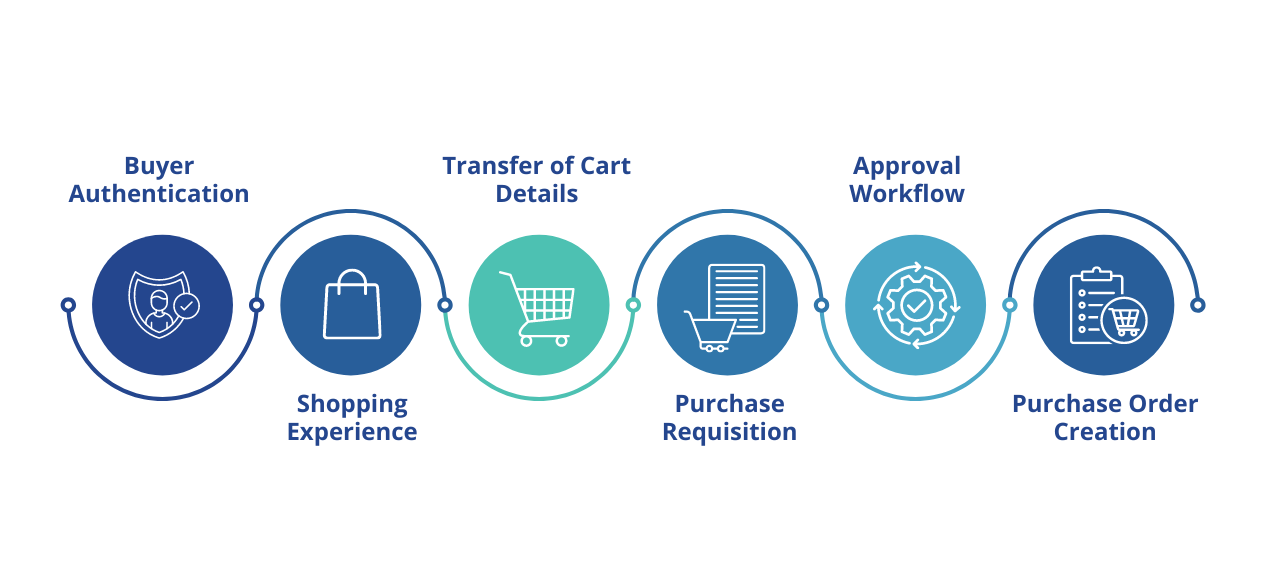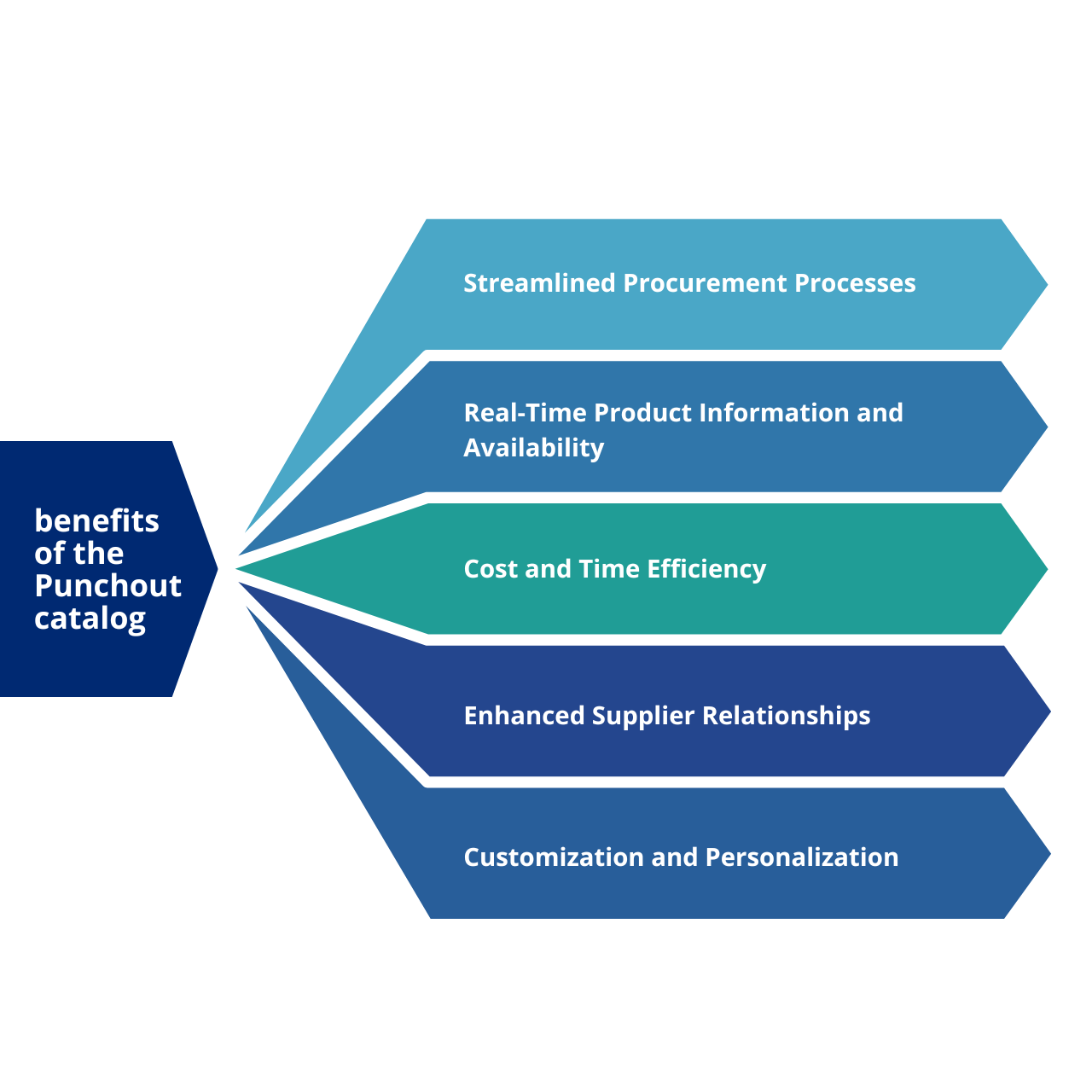As a procurement manager, I am navigating multiple supplier catalogs, trying to align purchases with corporate policies, and ensuring every transaction is as efficient as possible.
– Sounds familiar to you too?
This feels like there’s just too much to handle, and you desire a simpler, streamlined way to shop for your business needs. This is precisely where the Punchout catalog can make a difference.
Punchout catalogs transform the typical e-procurement by linking directly to a supplier’s online storefront within your company’s purchasing system. This seamless connection streamlines purchasing processes and tailors the shopping experience to match negotiated terms and prices.
The result? A more intuitive, error-free way to manage business purchases that integrates perfectly with your existing procurement strategies. But how much smoother could your procurement operations be with this technology? Read till the end and get all your concerns addressed.
Understanding the Basics of Punchout Catalog
Most B2B procurement businesses are optimizing their purchasing processes by educating themselves about Punchout catalogs. The essential function of a Punchout catalog is to enable buyers to “punch out” from their procurement system to the supplier’s online catalog.
Read more: Embracing Generative AI in Category Management for Purchasing
Before we dive into the details, let’s have a quick breakdown of everything you need to know about Punchout catalogs.
What is a Punchout Catalog?
A Punchout catalog, more accurately termed a Punchout website, serves as a bridge between a company’s procurement system and a supplier’s e-commerce website. It allows corporate purchasing agents to buy directly from a supplier’s website through their own procurement application or hosted eProcurement system.
The integration is typically achieved using protocols such as cXML (Commerce eXtensible Markup Language). It facilitates the communication between the buyer’s procurement system and the supplier’s e-commerce platform.
Types of Punchout Catalog
As businesses seek efficient procurement solutions that enhance flexibility and control, paying close attention to the various types of Punchout catalogs is vital. Here is an insightful exploration of the distinct types of Punchout catalogs, functionalities, and roles in modern e-procurement strategies.
There are two primary types of Punchout catalogs that businesses can utilize. It includes:
Level 1 Punchout Catalogs
Functionality
Level 1 Punchout catalogs act as a gateway that takes users from their procurement system directly to the supplier’s e-commerce site. Once on the site, users can browse and add items to their cart.
Advantages
Users access the full range of products offered by the supplier, often with detailed descriptions and updated information.
Disadvantages
The process requires users to navigate away from their native procurement system to shop. This might lead to a less streamlined process and potential integration issues.
Level 2 Punchout Catalogs
Functionality
Level 2 Punchout catalogs provide the supplier’s catalog data directly into the buyer’s procurement system. This allows users to browse and compare products across multiple suppliers without leaving their procurement environment.
Advantages
This integration provides a seamless user experience, and effective comparison of shopping and decision-making without switching between different platforms. It enhances efficiency and reduces the time spent on the purchasing process.
Disadvantages
More complex backend integration is required, and not all e-procurement systems may support Level 2 catalogs. This type necessitates more extensive data management and updating processes.
Simplifying B2B Transactions: A Look at How Punchout Catalogs Work
In this evolving marketplace, B2B transactions demand efficiency and precision. With a single step into the process of Punchout catalogs, companies can advance into a streamlined procurement process. It integrates seamlessly with its own procurement systems.
This seamless integration automates authentication and simplifies the transfer of cart data back to the procurement system. This impacts transforming a complex procurement process into a simple e-commerce shopping experience.
The process of Punchout catalog typically involves six steps.
Buyer Authentication
A buyer logs into their eProcurement system and selects a supplier’s catalog. The system authenticates the buyer and establishes a secure session.
Shopping Experience
The buyer is redirected to the supplier’s e-commerce site, where they can browse through the products and add desired items to their shopping cart.
Transfer of Cart Details
Once shopping is completed, the cart’s content is transferred back to the eProcurement system.
Purchase Requisition
The eProcurement system converts the shopping cart into a purchase requisition.
Explore Zycus’ Purchase Requisition Management Software Solution
Approval Workflow
The purchase requisition is routed internally for necessary approvals, adhering to the company’s procurement policies.
Explore Zycus’ Invoice Approval Workflow Software for AP Automation
Purchase Order Creation
Upon approval, a purchase order is created and sent to the supplier, completing the procurement cycle.
Explore Zycus’ Purchase Order Management Software
Punchout Catalog in Action: Example
An organization named “A” needs to procure office supplies. They have an existing procurement system where their employees log in to make purchase requests. Company A has a preferred supplier for office supplies, and Company B provides them with special pricing and a customized product range.
Below is a detailed illustration of the Punchout catalog example:
- Employee Login: An employee of Company A needs office logistics. They log into Company A’s procurement system to start the purchase process.
- Accessing the Catalog: Within the procurement system, the employee selects the Punchout catalog for Company B. The system automatically authenticates the employee’s credentials with Company B and opens their online catalog within the procurement system interface.
- Browsing and Selection: The employee browses through the online catalog, which displays products with pre-negotiated prices and terms specific to Company A. They select the desired item and add it to the shopping cart.
- Transfer to eProcurement: Instead of proceeding to check out on Company B’s website, the employee transfers the shopping cart back to Company A’s procurement system as a purchase requisition with just a click.
- Approval and PO: The purchase requisition is routed through Company A’s internal approval workflows. It then gets approved internally and sent back as a purchase order to Company B.
- Order Fulfillment: Company B receives the purchase order, processes it, and ships the item to Company A. They also send an electronic invoice, which Company A’s system matches with the purchase order for payment processing.
The Secret Weapon Hiding in Your Procurement System: Punchout Catalogs
Punchout catalogs represent a significant leap forward from traditional procurement methods. It emerges as one of the secret weapons offering benefits that go beyond simple transactional improvements to providing strategic business advantages.
Following are some of the business benefits of the Punchout catalog:
Streamlined Procurement Processes
Punchout catalogs integrate directly with your eProcurement systems, offering a seamless interface for accessing supplier catalogs.
Real-Time Product Information and Availability
Suppliers can update their product details, prices, and availability in real-time. It ensures that businesses always have the most current information at their fingertips.
Cost and Time Efficiency
By automating data transfer between procurement systems and supplier catalogs, Punchout catalogs reduce the need for manual data entry, thereby minimizing errors and saving time.
Enhanced Supplier Relationships
Punchout catalogs facilitate better communication and data exchange between buyers and suppliers. This helps in negotiating better terms and building strong, strategic partnerships with suppliers.
Customization and Personalization
Suppliers can customize their offerings and pricing in Punchout catalogs to fit the specific needs of each buyer. This level of personalization ensures that buyers can always find what they need at the best possible terms.
Conclusion
Punchout catalogs represent a transformative approach to B2B transactions, enabling businesses to operate with greater efficiency, accuracy, and strategic insight. As companies continue to embrace digital solutions, the adoption of Punchout catalogs is likely to become more prevalent, setting a new standard for e-commerce and procurement activities.
Your business’s purchasing process can become seamless, right from browsing to order fulfillment. With Zycus’ Punchout catalog solution, this efficiency is not just possible; it’s within your grasp.
Curious to see how our Punchout catalog software can streamline your buying cycle? Request a free demo now- and watch your procurement transform from routine to remarkable.
Related Reads:
- What Is Procurement Catalog Management: Your AIO Guide
- Mastering Category Management in Purchasing: A Short Guide
- Procure to Pay: A Comprehensive Guide
- Demystifying Procure-to-Pay Accounting — A Beginner’s Guide
- Procure to Pay Analytics: Definition, Importance & Examples
- Intake to Pay vs. Procure to Pay: Key Differences and Selecting the Right Approach
- Solution: Procure to Pay Software
- White Paper: Best Practices Driving Procure-to-Pay Efficiency
- White Paper: Procure to Pay Transformation Guide
- White Paper: Driving Procure-to-Pay User Adoption Through Change Management Focus
- White Paper: Managing Procure to Pay Risks with the Right Mix of Processes and Technology













































